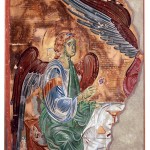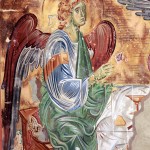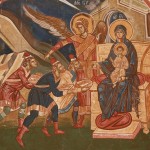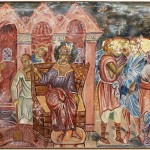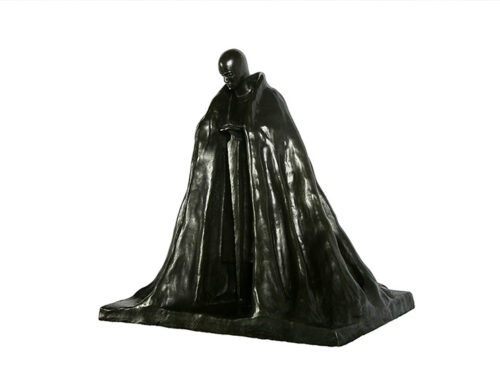Rajko Nikolic (Veliki Bozinac, 1926 – Belgrade, 1991)
Angel
Copies of the frescoes in the monastery …
Casein tempera on prepared linen canvas
258 x 128cm
Inv. No. 46/01
The story of Joseph I
Copy of a fresco fromthe narthex of the monastery Sopoćani
Casein tempera on prepared linen canvas
130 x 296 cm
Inv. No. 43/01
The story of Joseph II
Copy of a fresco from the monastery Sopoćani
Casein tempera on prepared linen canvas
135 x 317cm approx
inv . No. 44 / 01
Adoration of the Magi
Copy of a fresco from the south choir of monastery Decani
Casein tempera on prepared linen canvas
228.5x 443 cm
Inv. No. 45 / 01
Unidentified young saint,
A copy of a fresco from the southwest column of monastery Sopoćani
Casein tempera on linen prepared canvas
259 x 105.5cm
Inv. No. 47/ 01
Five copies of medieval frescoes from Serbian monasteries are kept within the art collections of the Royal Compound. All fresco copies are located in the Royal Palace , in the ceremonial entrance hall. The story of copies of frescoes in the palace in Dedinje is closely linked to the cultural policy of the country and the formation of public art collection in the period between1947 and 1956. After the Second World War the cultural policy of the country was focused primarily on the construction of the new identity of the state, which was based on emphasizing Yugoslav unity and common cultural heritage. In 1947. Yugoslav Government formed the Committee for Culture and Arts headed by the most important figures in the arts and sciences of the time from all Yugoslav republics. The aim of the Committee was the implementation of national cultural policies in the nation and the protection and propagation of a common cultural heritage. One of the first steps of the Committee was to work towards the realization of the exhibition which would present the medieval art and culture of the Yugoslav peoples. In this respect, the most significant artists and fresco copyists of the time worked together with the French conservators on copying medieval frescoes, sculptures and architectural details in the whole of Yugoslavia. This whole project resulted in a major exhibition of Yugoslav medieval art, which was held in 1950 in the Chaillot Palace in Paris. For the purposes of this exhibition, among other things, a number of copies of frescos from Serbian monasteries were made. After the end of the exhibition in 1953. those fresco copies (total of 160) represented the main fund and incentive for the opening of the Gallery of Frescos, the second museum of its kind in the whole world.
At the same time, the Cabinet of the President of the Republic (CPR) has formed a committee for arranging the palaces in Belgrade. So a few copies of frescos occurred in the Royal palace, and later this collection was supplemented by special CPR orders of an additional number of copies.
All fresco copies are the work of Professor Rajko Nikolic .
Rajko Nikolic painter, fresco copyist, professor and dean of the Academy of Applied Arts in Belgrade. Born in 1926 in Great Bozinci . He was a student of the famous copyist Vladimir Predejevic , who, together with Vrbicki and other Russian artists ( Russian immigrants) worked on the copying of the frescos in Oplenac . After Predojevic left the Academy of Applied Arts, he was replaced by his pupil.
Rajko Nikolic did 33 copies for the Gallery of Frescoes in Belgrade between1948 and1959. He started working as a copyist at the Academy of Applied Arts . He worked in the monastery Zica, in St. Ahilije church, Monastery Decani, Monastery Manasija and Hagia Sophia in Ohrid.
He was a professor and dean of the Faculty of Applied Arts and Design in Belgrade.


